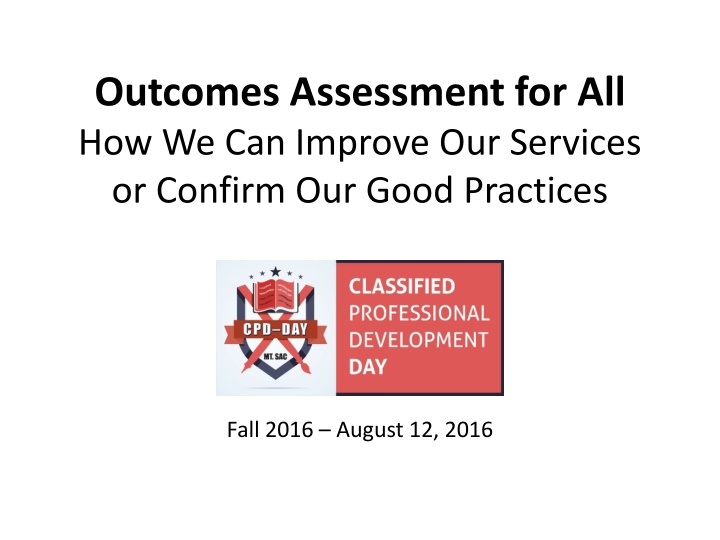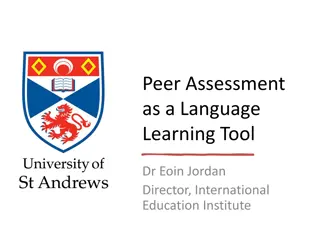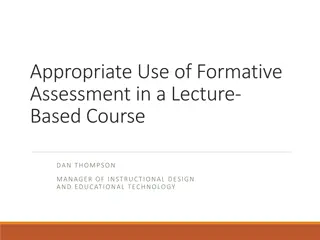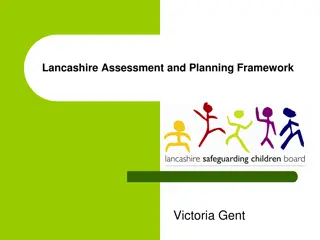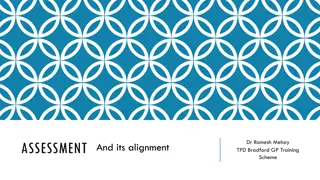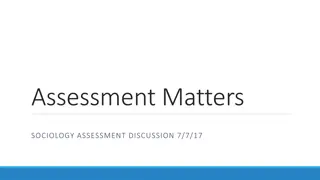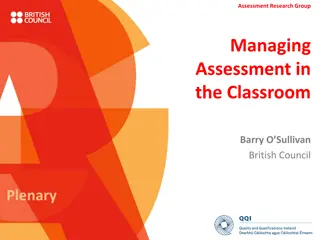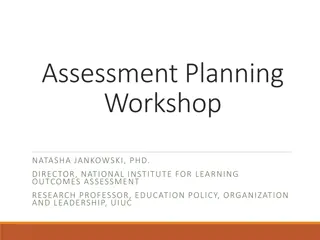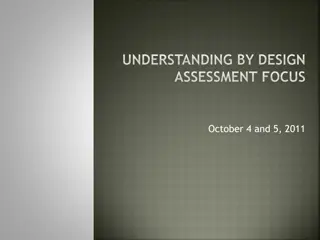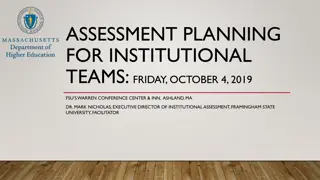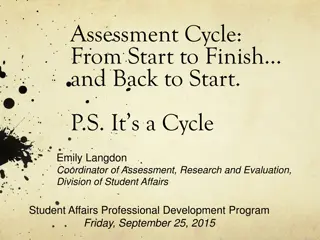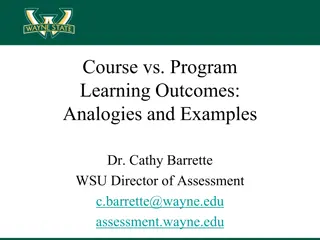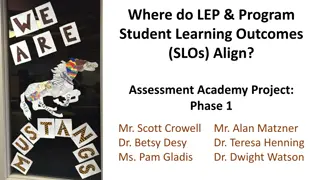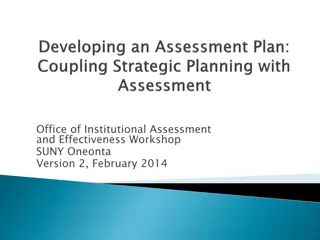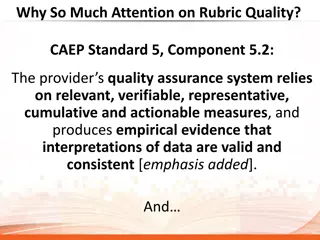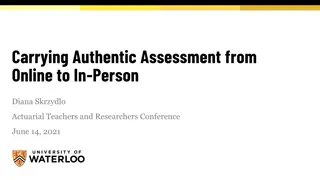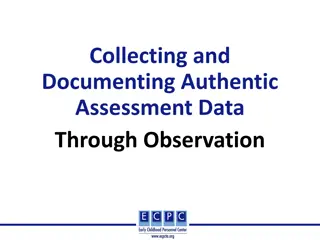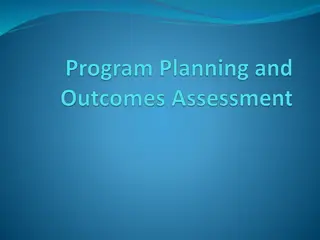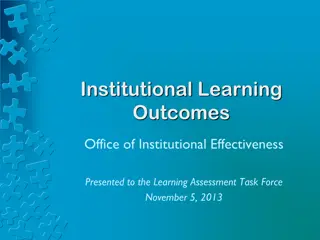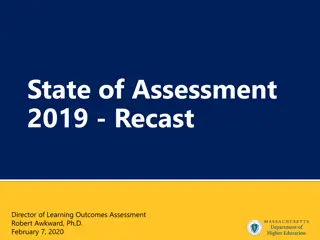Improving Services Through Outcomes Assessment
In this session, attendees will learn the importance of involving classified staff in the outcomes assessment process for effective service delivery. The focus will be on setting and assessing student learning outcomes and administrative unit objectives, with a practical approach to creating surveys for service improvement. Explore the reasons behind outcome assessment and methods for evaluating outcomes to enhance service quality.
Download Presentation

Please find below an Image/Link to download the presentation.
The content on the website is provided AS IS for your information and personal use only. It may not be sold, licensed, or shared on other websites without obtaining consent from the author.If you encounter any issues during the download, it is possible that the publisher has removed the file from their server.
You are allowed to download the files provided on this website for personal or commercial use, subject to the condition that they are used lawfully. All files are the property of their respective owners.
The content on the website is provided AS IS for your information and personal use only. It may not be sold, licensed, or shared on other websites without obtaining consent from the author.
E N D
Presentation Transcript
Outcomes Assessment for All How We Can Improve Our Services or Confirm Our Good Practices Fall 2016 August 12, 2016
What interests you today? Program Description: Including classified staff in the outcomes assessment process is important for the effective delivery of instruction and services across the campus. In this session, attendees will learn why it is useful to set and assess student learning outcomes (SLOs) and administrative unit objectives (AUOs). In addition to reviewing why we assess, attendees will learn how to assess. By the end of this session, attendees will have created a draft survey, which could be used to improve services or confirm good practices. Please write briefly about your interest in our session.
Introductions Annel Medina Tagarao Educational Research Assessment Analyst Emily Woolery Librarian (Faculty Outcomes Coordinator) Mark Lowentrout Associate Dean, Arts Division (Management Outcomes Coordinator) Please introduce yourself
Session Outcomes After attending the presentation, Outcomes Assessment for All, attendees will be able to: Identify reasons for creating and assessing student learning outcomes (SLOs) and administrative unit objectives (AUOs). Identify methods for assessing SLOs and AUOs. Create surveys that assess outcomes.
Outcomes Assessment improves our services. We can improve our services when we set goals and assess desired outcomes: 1. Identify desired results of our service 2. Collect and analyze data or information 3. Discuss findings with department or area 4. Improve our service
Outcomes Assessment is a requirement. ACCJC: Outcomes assessment is required in all instructional programs and student and learning support services. *Accrediting Commission for Community and Junior Colleges PIE: Units, managers, and vice presidents must report progress on outcomes assessment. *Planning for Institutional Effectiveness
HOW CAN WE ASSESS OUTCOMES? Step 1: Identify desired results of our service.
Outcomes Statements identify our desired results. Administrative Unit Objective (AUO): What will clients experience, receive, or understand as a result of a given service? Student Learning Outcome (SLO), Course Measurable Objectives (CMO) and Program Learning Outcome (PLO): What will students or clients know, think, or do as a result of a course (SLO) or degree/certificate (PLO)? Institutional Level Outcome (ILO): What knowledge, skills, abilities, and attitudes will students develop as a result of their overall experiences with any aspect of the college?
Administrative Unit Objectives (AUOs) follow a general format. Format 1: Intended audience who action verb 1 program/service will be able to action verb 2 intended outcome. Example: Students who attend the Resume Workshop will be able to create cover letters that concisely state their qualifications for the job. From Lane College - http://www.lanecollege.edu/text/stepsindevelopingassessmentplan.pdf
Administrative Unit Objectives (AUOs) follow a general format. Format 2: Intended audience or the department will be able to action verb to describe what it will do, achieve or accomplish. Example: The Career Center will increase student attendance at the Resume Workshop. From Lane College - http://www.lanecollege.edu/text/stepsindevelopingassessmentplan.pdf
Administrative Unit Objectives (AUOs) Let s practice writing AUOs! Using the two formats of AUO statements, write AUOs that could be used in your area.
Administrative Unit Objectives (AUOs) Need some hints? Intended audience: students, faculty, staff, employees within department, administrators Action verb 1: complete, participate in, request Program/service: respond to maintenance requests, process payments, provide safe grounds Action verb 2: describe, discuss, explain, identify, list, prepare, use, select, plan, create
CAN WE EASILY CREATE SURVEYS TO ASSESS OUTCOMES? Step 2: Collect and analyze data or information.
Qualtrics Qualtrics is a web-based survey software tool available for use by all faculty, staff, and students. Qualtrics can be used to capture survey results from a publicly-available survey, or from users who are specifically given access to a survey. We find Qualtrics on the campus website of Professional & Organizational Development. http://www.mtsac.edu/pod
Qualtrics What does a survey look like after we create it using Qualtrics? Start at the Outcomes website: http://outcomes.mtsac.edu **Workshop Survey** is near the top. Let s see our results.
Qualtrics Let s create surveys for your areas. 1. Find Qualtrics at the POD website. 2. Login to Qualtrics. 3. Create a survey of at least two questions.
What did you learn today? What did you learn today? How can you apply outcomes assessment and surveys in your area? Write briefly about what you can/will use in your area.
Do you have any questions? Thank you for joining us today!
